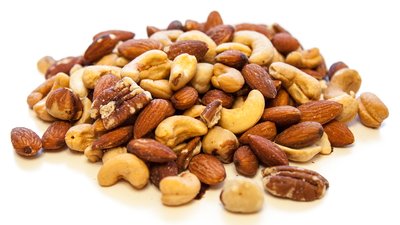Vendors walking the aisles at baseball games are wiser (and less obscene) than they know when they yell to "get your nuts." The days of ultra low-fat diets that starve the body of healthy nutrients are gone. Healthy fats are now considered a pillar of any healthy diet, and leading the charge into this new era are nuts.
Every year seems to bring new evidence that nuts are nature's most versatile, nutritionally balanced health food. And yet, they continue to be cast aside by many as fatty junk food. We must be nuts as a society not to shout the virtues of shelled snacks from the treetops!
The case for nuts doesn't end with fatty acids, which have been shown to help lower cholesterol levels among many other benefits. Nuts have also been shown to help provide an edge against stroke and type 2 diabetes, curb appetite, and encourage weight loss, as studies indicate that calories from nuts don't always correlate with the expected amount of weight gain. Nuts also give vegetarians a guiltless protein source that rivals any meat, and they mix well any number of diverse dishes.
However you spread it, nuts should be a part of a healthy diet plan. Here, then, are our top five, in no particular order:
1. Almonds
They're everywhere: in salads, on pizzas, as snacks with all manner of seasonings - they even have their own milk. With good reason: Almonds rank among the highest-protein nuts, but at a fraction of the price of some higher-end nuts like walnuts. Almonds are also high in manganese and vitamin E, vital defenders against oxidative damage.
Those who consume almonds on a regular basis are at lower risk for developing heart disease. One study even found they actually help lower elevated cholesterol.
What are you waiting for? Consider topping your salads with slivered almonds or snack on a few with your mid-afternoon protein shake.
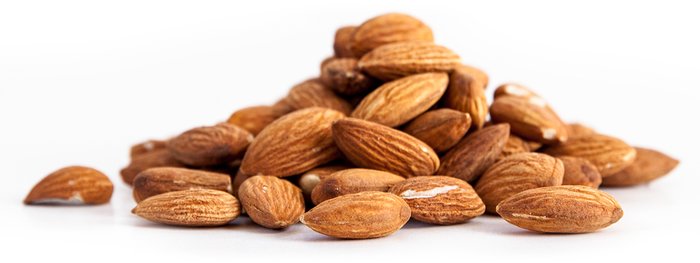
What's in an ounce of almonds?*
Nutrition Facts
- Serving Size 22, dry roasted without salt
- Amount per serving
- Calories: 169
- Total Fat: 14.8 g
- Total Carb: 8.3 g
- Protein: 5.9 g
Other significant vitamins/minerals: riboflavin, vitamin E, calcium, magnesium, phosphorus, zinc.
2. Walnuts
The word superfood gets tossed around in respect to walnuts more than any other nut. This basically means while we now know walnuts are nutrient-packed, we're still in the process of discovering all the benefits they can bring.
Among the latest studies was one that found that walnuts may actually enhance reasoning skills in teenagers! Considering the insane popularity of Justin Bieber, this is no small feat.
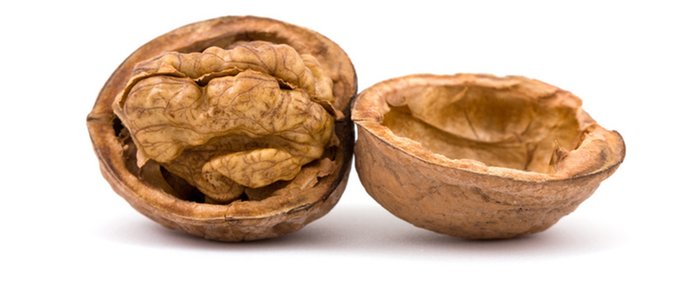
Much of the walnut's stellar reputation comes from its richness in essential fatty acids, particularly alpha-linolenic and linoleic acid.
A well-publicized study in 2006 found that the fatty acids derived from regular walnut consumption decreased subjects' total cholesterol level and LDL cholesterol in short-term trials.
And you don't have to eat a tree's worth to see the benefits!
Just a quarter cup serving of walnuts daily provides almost 100 percent of the total recommended omega-3 fatty acid intake and contains just 163 calories. Just a one-ounce serving has more omega-3s than a 4 oz piece of salmon.
Walnuts also contain phytonutrients and antioxidants that are known to be helpful in reducing inflammation levels and warding off type 2 diabetes. Another interesting walnut factoid: They're a rich source of melatonin, which encourages a healthy sleep cycle.
What's in an ounce of walnuts?
Nutrition Facts
- Serving Size 14 halves
- Amount per serving
- Calories: 185
- Total Fat: 18.5 g
- Total Carb: 3.9 g
- Protein: 4.3 g
Other significant vitamins/minerals: thiamine, vitamin B6, copper, phosphorus, magnesium, zinc.
3. Pistachios
Pistachios are often dismissed as diet busters, but these nuts provide clear health benefits.
Pistachios are lower per-nut in calories than other nuts, but are quite high in protein and fiber. They also shine in vitamin B6 content, providing 18 percent of daily requirements, whereas most other nuts fall below five percent of that metric.
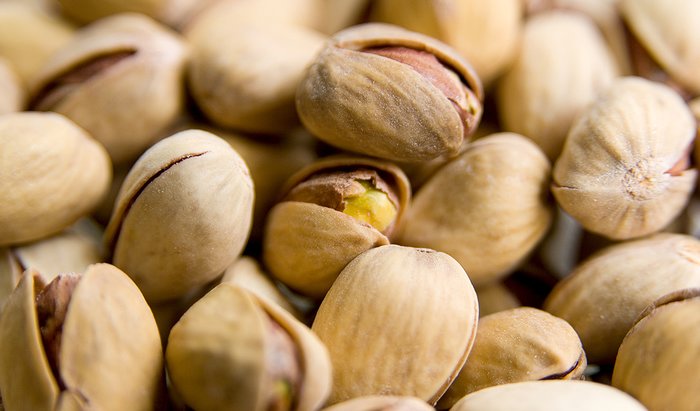
Pistachios are also the inspiration behind the "pistachio effect," an interesting approach to eating highlighted in a recent study at Eastern Illinois University. The authors of the study found that subjects who were offered pistachios in shells ate an average of 125 calories worth of nuts, whereas those who were offered shelled nuts consumed an average of 211 calories. However, participants on both sides rated their fullness and satisfaction the same, despite the difference in calories.
The Takeaway: Eating more slowly and mindfully can help you stick to caloric restrictions and get more satisfaction through less food. Your mother always told you that eating slowly was better for you, and here's proof mom may have been onto something. So take your time and savor this healthy comfort food!
What's in an ounce of pistachios?
Nutrition Facts
- Serving Size 49, dry roasted without salt
- Amount per serving
- Calories: 161
- Total Fat: 12.7 g
- Total Carb: 8.3 g
- Protein: 5.9 g
- Fiber: 2.8 g
Other significant vitamins/minerals: thiamine, vitamin B6, iron, manganese, magnesium, phosphorus, potassium, zinc.
4. Cashews

Cashews have a buttery, fatty flavor that puts them right up with macadamias as the most feared nuts. Fear not! Cashews are one of the most nutrient-rich nuts in the orchard, with plenty of iron, zinc, and trace minerals.
A 1 oz serving provides nearly a quarter of your daily phosphorus requirements!
The calories add up quickly when snacking on cashews, but it's worth noting that a recent study found that weight-loss diets that allow nuts have greater compliance among dieters, and better results, than diets that don't!
What's in an ounce of cashews?
Nutrition Facts
- Serving Size 18 halves and pieces, dry-roasted without salt
- Amount per serving
- Calories: 163
- Total Fat: 13.1g
- Total Carb: 9.2
- Protein: 4.3 g
- Omega-3 Fatty Acids: 7.7 g
- Fiber: 1 g
Other significant vitamins/minerals: thiamin, vitamin B6, iron, magnesium, manganese, phosphorus, zinc.
5. Peanuts
Sometimes you learn as an adult that you had it right as a kid. That bag of nuts is definitely the healthiest thing you can eat at the ballpark!
Peanuts come in endless flavors and mixes of varying nutritional worth, but for many of us, they are still first and foremost the base of peanut butter. But not all peanut butters are created equal! When shopping, look for natural varieties with oil on top.
These varieties contain less sugar and added ingredients. Also consider making your own in your blender or food processor. It's easier than you think and there's no step down in taste.
Peanuts are one of the great energy foods, no matter if you're an athlete or a desk-jockey trying to maintain focus through a long work day. They are high in protein, dietary fiber, and antioxidants.
Consuming peanuts also reduces the chances of stroke, as they increase your natural production of nitric oxide, which dilates blood vessels.
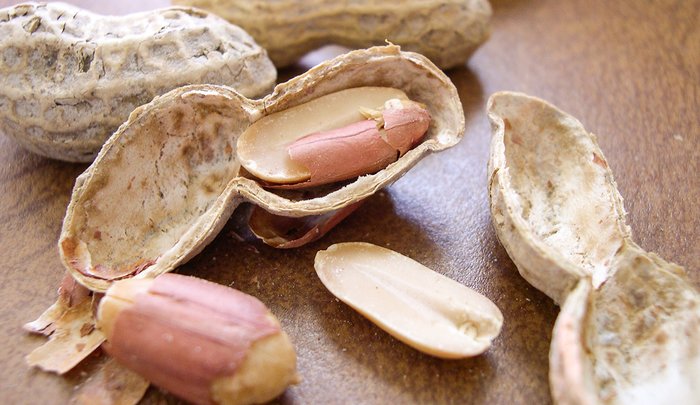
What's in an ounce of peanuts?
Nutrition Facts
- Serving Size 35, dry roasted without salt
- Amount per serving
- Calories: 166
- Total Fat: 14.1 g
- Total Carb: 6.1 g
- Protein: 6.7 g
- Fiber: 2.3 g
Other significant vitamins/minerals: potassium, phosphorous, calcium, magnesium, niacin, vitamin E, folate.

